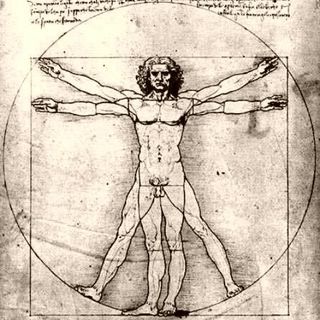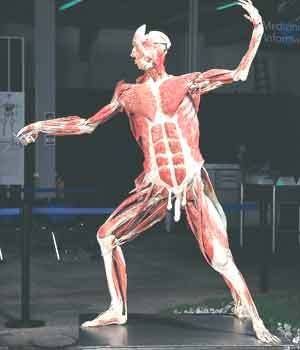I have never had a very strong stomach, a fact which led me to fail Biology in high school because of a marked number of absences on days in which dissections were to take place. So right before I entered the Body Worlds exhibit at the California Science Center (described to me as “a biology textbook come to life”) I took a deep breath and reminded myself that, this time, ditching was not an option. My only hope was that I would find this exhibit to be more artistic than disgusting. I was more than happy; I was relieved to find that Dr. Gunther von Hagens’ “Body Worlds: The Anatomical Exhibition of Real Human Bodies” exceeded my hopes. Dr. von Hagens did an excellent job of introducing and exhibiting works of a new style of Anatomical Realism.
As I came face to face with my first dissected body I found that von Hagens’ plastination process had hardened all the normally soft and squishy human parts, which made the bodies look comfortingly fake and also hauntingly beautiful. I was delighted to find that, not only was I not passing out from horror and disgust, but that I found the entire body quite aesthetically pleasing. The bodies I was dreading were more like works of art that filled my imagination and piqued my curiosity— each body drawing me further and further into the exhibit and touching me on so many different levels, as all good works of art should do.
I attended the exhibit with my best friend who, like me, is an art history student. So it wasn’t too unlikely that we both found ourselves drawn to the artist renderings of human figures that were hung on the walls surrounding the plastinated bodies and body parts. We seemed to be the only two people in the over-crowded room who could tear their eyes away from the physical exhibits to appreciate the artwork on the walls. We stood in front of the oversized banners that hung from the ceilings and stared at the beautiful detailed sketches of limbs, muscular structures, and nude bodies. The effect that these banners was two-fold—they were aesthetically pleasing but also worked to give a nod to the artists of the past whose works, that bridged both art and science, were the stepping stones that made this exhibit possible many years later. I especially liked the addition of the drawings to the exhibit because it was nice to see wonderful examples of the two styles of Anatomical Realism intermixed, the old amongst the new.
The first style of Anatomical Realism had, until the opening of Body Worlds, been the only style for a very long period of time. The most famous of all Anatomical Realists was Leonardo DaVinci whose most famous anatomical drawing is the “Vitruvian Man” (see Fig. 1) which was one of the artworks displayed in the exhibit. As you can see by the drawing, this style aimed to show a higher reality of dissection by displaying beautiful, idealized bodies and body parts that float in the air with no reference to any one dissected person. These drawings were beautiful and always strived for perfection. The early anatomical illustrations began to achieve greater technical precision as knowledge about the boundaries and surfaces of the human body, due to scientific studies (and grave robbing), became more sophisticated.
The second style of Anatomical Realism is a direct result of the knowledge gained by those anatomical illustrations. Body Worlds is a perfect example of that newer style which aimed to show the reality of dissection— the cutting open of a particular body with all the furniture of the dissection. It shows the ugliness of anatomical mutilation (see Fig. 2). Until plastination this art style has not been able to be offered for mass viewings by the general public.
There are many people who viewed this exhibit with disgust. There are many people who questioned the ethics behind it. There are many people who were outraged and upset over the very existence of it. I am not one of those people. In fact, I had a hard time trying to see the exhibit any way other than a highly stylized art exhibit. I did not encounter one negative feeling while walking from one art piece to the next and, in fact, found the much-debated “Pregnant Woman” to be the most artistic of all the pieces.
Many of the people around me exclaimed how “sick” it was that von Hagens had her “posing” like a “sexual object.” I understood that viewers were taking issue with the position of her arm, slung up over her head in a way that could be taken to be sexually suggestive. Later that night, as I was lying in bed, that particular piece stayed with me. I began to wonder if there was another way von Hagens could have displayed her body that would have been less controversial. I shifted onto my side and played with that idea as I played with the position of my arm. No matter where I placed it, my arm interfered with or blocked the sight of my stomach. It became obvious that her “pose” was the perfect way to display the beauty of her pregnant stomach. Even more, it was a uniquely feminine position that displayed the deeper meaning and entire point behind this particular body— a woman who had the ability to create and sustain the life of a child.
Dr. Gunther von Hagens is not only a scientific pioneer, but also a very talented and groundbreaking artist. I have sat in many Art History classes and walked through hallways filled with artwork in all kinds of museums of all kinds of genres, and this exhibit was unlike anything I had ever seen. Because of “Body Worlds” I got the chance to experience a new style of Anatomical Realism that enriched my mind and helped me experience a style of art in a brand new and exciting way. Von Hagens’ exhibit should not only be celebrated for its scientific advancements but also for its undeniable artistic value.
 fig. 1
fig. 1 fig. 2
fig. 2Copyright Megan Tharpe 2005


No comments:
Post a Comment